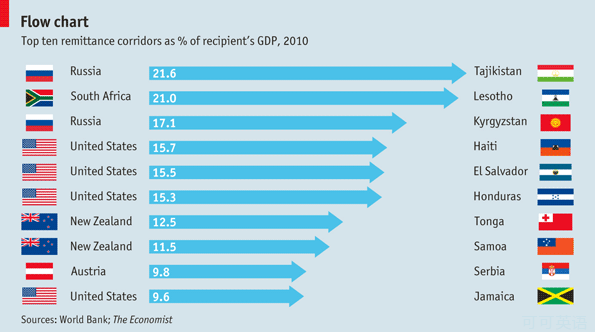Finance and Economics;New rivers of gold;Remittances from unlikely places are helping poor countries in the downturn;
財經;新的資金流向;意外的匯款在經濟低迷時幫助貧困國家;
In tapachula, a furnace of a city in southern Mexico, people line up inside an air-conditioned branch of Banco Azteca to process their remittances. Last year Mexicans received an estimated $24 billion from friends and family working abroad, mainly in the United States, with which Mexico forms the world's busiest remittance corridor (see map). But a closer look at the Tapachulan queue shows how the remittance business is changing. Many are not Mexicans receiving cash from America, but migrant workers sending it back home to Guatemala or Honduras. “Very similar to what happens at the other border,” observes Jorge Luis Valdivieso, the bank's regional administrator, referring to Mexico's better-known northern frontier.
他伯拉在墨西哥南部一個火爐區域,這里的大部分人阿紫別克銀行的一個有空調的房間內排隊處理他們的匯款。去年墨西哥人從海外朋友和家人那里得到大約240億美元,大部分來自美國,為此墨西哥成了世界上最防盲的匯款渠道(如地圖)。但是近距離觀察塔帕丘拉的長隊發現匯款業務怎么變化。大部分不是墨西哥人從美國得到現金,而是移民工人匯回他們的家鄉危地馬拉和洪都拉斯。“這與另一邊的邊境發生的情況很相似,”Jorge Luis Valdivieso說,這個銀行的區域行政長官,指的是墨西哥著名的北部邊境地區。

The value of remittances to poor countries is enormous. Since 1996 they have been worth more than all overseas-development aid, and for most of the past decade more than private debt and portfolio equity inflows. In 2011 remittances to poor countries totalled $372 billion, according to the World Bank (total remittances, including to the rich world, came to $501 billion). That is not far off the total amount of foreign direct investment that flowed to poor countries. Given that cash is ferried home stuffed into socks as well as by wire transfer, the real total could be 50% higher.
這些匯款的價值對于貧窮國家來說是巨大的。自從1996年其價值已經超過了所有的海外發展救助資金,并且對于過去的十年來說其價值超過了私人債券和股票的流入。在2011年匯向貧窮國家的總額已經達到3720億美元,根據世界銀行的統計(總匯款,包括流向富裕國家的,已經達到5010億美元)。這與流向貧窮國家的總的外資直接投資相差不遠。這些錢可能通過裝在襪子里偷渡回家或通過電匯到家,真實總額可能要高出50%。
Remittances are not just big, but growing—they have nearly quadrupled since the turn of the millennium—and resilient. In 2009, when economies around the world crashed, remittances to poor countries fell by a modest 5%, and by 2010 had bounced back to record levels. By contrast, foreign direct investment in poor countries fell by a third during the crisis, and portfolio inflows fell by more than half. “The most remarkable thing about remittances today is their continued growth, year after year, despite the global economic crisis,” says Dilip Ratha, head of migration and remittances at the World Bank.
這些匯款不僅數量大,而且不斷增長并且有彈性,在千禧年左右匯款增加了量增加了四倍。在2009年,世界經濟下滑的時候,匯向貧窮國家的錢稍微下降了5%,并且到了2010年這有反彈到歷史水平。相反,在經濟危機期間外資直接向貧窮國家的投資下降了三成,證券投資流入下賤了一半。“盡管世界經濟危機的今天匯款最大的特點就是其數量年復一年的增長,”Dilip Ratha說,世界銀行移民和匯款長官。
One reason for this apparent boom is simply that the data are better. Money senders such as Western Union and MoneyGram have improved their reporting to central banks. Oversight has tightened since September 11th 2001. This has led to big jumps in some numbers: Nigeria posted a near-doubling of remittance receipts in 2007. Where governments are sensitive about providing information, economists have used other methods. India, for instance, subjects remittances to Bangladesh to stringent tests. But by examining migration data, the World Bank reckons that some $3.8 billion probably crosses the border every year.
明顯增長的一個原因是數據更容易得到了。匯款郵寄公司譬如西部聯合公司和速匯金公司已經提高其對中央銀行的上報。自從2001年9月11日起已經加強了監管力度這導致匯款大數量的增加,尼日利亞報告2007年匯款收入將近翻了一番。 那些政府對上報信息敏感的地方,經濟學家已經采取了其他的方法。比如印度對于匯向孟加拉國的匯款進行嚴厲的檢查。但是通過檢查銀民數據,世界銀行預計每年有38億美元穿越邊境線。
Partly thanks to these techniques, it is now known that remittances come from a wider variety of countries than was previously thought. This might in turn explain how they have avoided being affected by Wall Street's hiccups. In 1970 46% of recorded remittances were reckoned to originate in America. By 2010 America's share was just 17%. One big new player is the Gulf, which has sucked in migrant workers since the oil boom. Saudi Arabia is now the world's biggest sender of remittances after America, posting $27 billion in 2010, mostly to the families of South Asians and Africans who toil on its building sites and clean its homes. More than half of all remittances to South Asia come from the Gulf; worldwide, the region sends almost as many remittances to poor countries as western Europe does.
部分歸因于這些技術,現在知道匯款比以前認為的來自更多的更大范圍的國家。這也可以解釋為什么他們能夠不受華爾街震蕩的影響。在1970年46%有源可查的匯款來自美國。到2010年美國的份額只占了17%。一個新的大玩家來自海灣地區,自從石油經濟暴增吸引了大批的移民工人。現在沙特阿拉伯是自美國之后最大的匯款輸出國,在2010年寄出了270億美元,大部人到了南亞和非洲家庭中,他們用這些錢整理房屋清理房間。所有的匯款中超過一半是從海灣地區郵寄到南亞地區的;世界范圍內,這些地區向貧窮地區送出的匯款大致與西歐國家持平。
Expensive oil has made Russia a big destination for immigrants, too. In 2000 it was only the 17th-biggest remitter in the world—indeed, it was a net receiver. But by 2010 it was the fourth-largest sender, dispatching nearly $19 billion, mostly to Central Asia. Remittances from Russia are worth more than a fifth of Tajikistan's economy (see chart).
高昂的石油價格也俄羅斯成為一個巨大的移民輸入地。在2000年的時候它實際上只是世界第十七位匯款輸出國,他是凈輸入國。到了2010年它是第四大輸出國,輸送了大概190億美元,大部分輸送到中亞地區。來自俄羅斯的匯款相當于塔吉克斯坦整個經濟的六倍(見圖表)
Though they are less volatile than many types of income, remittances are not immune to fluctuations. Cash flows to Mexico last year were still 12% lower than their pre-crash peak, partly because many Mexican migrants worked in the American construction sector, which is still reeling. The “Arab spring” of 2011 made a dent in remittance receipts in the Middle East and Africa, as migrant workers from the region fled countries such as Libya. An exception was Egypt, where receipts shot up by 14%. One reason may be that exiled Egyptians returned home with their savings; another is that a fall in property prices encouraged émigrés to snap up bargains.
盡管并不像大部分類型的收入,匯款并不受經濟波動的影響。去年流入墨西哥的現金仍然比以前的最大值少了12%,部分死因為墨西哥裔移民大部分在美國建筑部門工作,這些仍在倒退中。在“阿拉伯之春”的2011年中東和非洲地區外匯收入下降了,因為移民工逃離一些國家例如利比亞。埃及一個例外,其進款猛增了14%。一部分原因是流亡的埃及人帶著他們的儲蓄回到家鄉;另一個原因是物價下降鼓勵一民工搶購廉價物品。
Currency fluctuations can also skew remittance patterns. American greenbacks and euros are no longer sought after in those African countries where currencies have appreciated sharply in real terms thanks to demand for the commodities they export. “When you send dollars back to a family in Angola, they don't feel as rich as before,” says Marcelo Giugale of the World Bank. Working in Europe for five years no longer buys a house back home.
現期的貨幣波動可能影響匯款模式。美元和歐元再不是非洲國家追逐的對象了。這些地區的貨幣急劇升值這歸因于對他們出口商品需求的增加,“當你送回美元到阿格拉家庭中的時候,他們不會像以前那樣感到富有。”來自世界銀行的Marcelo Giugale 說,在歐洲工作5年再也不能在家鄉購買一套房子了。
The question is whether migrants will react by spending longer in far-flung destinations, or by staying closer to home. Many already go for the second option: one-tenth of remittances to Africa come from within the continent. South Africa sends most of its $1.4 billion in remittances to its neighbours, for example.
問題是這些移民是否愿意為長遠的目標做出反映,或者呆在家里。很多人已經選擇第二個選擇了:十分之一匯向非洲國家的匯款來自歐洲國家。例如,南非已匯款形式想起鄰邦輸送1億美元。
In the rich world, many countries have closed their borders to protect home-grown workers. America has made its southern frontier harder to cross, which partly explains the slowdown in immigration from Mexico. Emigration has risen, too, since the economy stalled. But perhaps because they know it will be harder to come back, migrants are staying longer. According to the Pew Hispanic Centre, 27% of Mexicans deported from America in 2010 had been in the country for at least a year, up from 6% in 2005. That may help explain why remittances from America fell by only 5% in 2009, whereas in Britain, which has open borders with some of its biggest senders of immigrants, they fell by 27% (exchange rates played a part, too). Stricter border controls keep migrants in as well as out, and the remittances flowing.
在富裕國家,很多國家已經關閉器邊境以保護其本土的工人,美國已經使其南部邊境線變得更難穿越,這部分說明了墨西哥匯款的降低。自從經濟失速以后移民處境也增加了,但是可能因為他們知道回去更困難的,移民呆的時間更長了。根據裔研究中心的報告2010年27%被驅逐出境的墨西哥人至少在美國帶了一年,甚至有6%自2005年就在了。那可以幫助解釋為什么2009年來自美國的匯款僅僅下降了5%,然而在柏林,這個與其匯款輸送人所在國家開放邊境的下降了27%(匯率起了也起了一定的作用),嚴格的邊境控制使得移民進出保持相對不變,和匯款上升。












